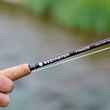“A fly reel’s job is to just hold line.”
You’ve probably heard that a thousand times. In most cases, that’s true. If you fish mountain streams where a nine-inch brookie is a trophy, playing fish from the reel isn’t a common occurrence. And you’ll never see your backing. But if you play in the salt, or anywhere else fish are measured in pounds and not inches, having a capable drag system can mean the difference between landing fish and burnt palms.
I grew up fishing the Northeast coast, with striped bass and bluefish the primary targets of my errant casts. Even my sweetwater quarry, the humble common carp that called the local duck ponds and drainage ditches home, was outsized by fly standards. I landed all manner of fish with a Pflueger Medalist, applying pressure with my fingertips. I yearned for a better way, so when the price on disc drag reels dropped to a level where snow shoveling money could pay for one, I jumped all over them.
I went through a number of bargain basement disc drag reels over the years, destroying most in the process. The early models weren’t sealed, and the ravages of sand and salt soon took their toll. I eventually picked up a Lamson model on sale, and was immediately enamored with its watertight construction. Over the years I’ve accumulated a few more from the manufacturer, so when the Speedster HD came out I had to try it out. The size of the spool, which dwarfed every other in its respective line class, intrigued me.
What Works
Massive Diameter
The Speedster HD is large, even by large arbor standards. The diameter of the spool on the biggest model, the Speedster 4 HD, is nearly five inches. This means you can take up line in a hurry, which is a huge asset when that false albacore turns toward you. I play my fish from the reel more often than not, and find the rate of retrieval to more resemble that of a Martin 72 SR multiplier than a direct drive reel. The large circumference also helps prevent line memory, with a quick stretch being all that is needed to shake the coils.
The HD
The “HD” variant is slightly different than the standard Speedster model, though their appearance is exceptionally similar. To keep small-diameter running lines from being pinched or escaping through the gap between the spool and the line guard, the HD model uses a full-cage design—you don’t need to worry about snags when using Spey and Scandi lines, shooting heads, or flat mono. Even though the reel is fully encapsulated by the cage you can still palm the spool thanks to the precision-machined rim that fits tightly over the cage.
Under Pressure
One of the hallmarks of Lamson’s engineering is the conical drag mechanism that packs a lot of material in a small space. By crafting a system that uses matched cones, the surface area of the friction washers is greatly increased over traditional designs utilizing flat washers in the same space. On fish to 35 pounds, I’ve never noticed any fade, though the runs of striped bass are not as prolonged as that of Bluefin tuna. False albacore and Atlantic bonito behave much like a member of the thunnus genus, and the reel has bested many members of those tribes with ease.
Sealed
I don’t swim with my reels like some surf anglers do, but I’ve never shied away from breakers either. Despite my best efforts, this reel has been dunked plenty in the waters of the North Atlantic. The small size of the unique drag system means the mechanism can be safely sealed against the elements with a couple O-rings. During the peak of the fall sand eel run, I can often be found right in the surf zone, taking wave after wave. This reel has suffered no ill effects from my aquatic misadventures.
Low Maintenance
The sealed nature of the drag means that no maintenance is required. In fact, it’s discouraged. The manual, as well as company reps I’ve spoke with, state that the spool should only be removed when swapping for another and no oils or additives of any kind should be ever used. Spool changes do take some getting used to, though. You simply yank the spool off the body of the reel, utilizing a straight pull. No levers to actuate or screws to turn. This perplexes many first-time Lamson owners, but it becomes second nature after you try it once.
Longevity
I’ve only been using this reel for four years now, but I have a Velocity, a now-discontinued mid-arbor model, on an eight-weight for the last fifteen or so years. In that time I’ve diligently rinsed the reel after every saltwater excursion, but that has been the extent of the upkeep. There are a couple of dings in the anodizing where it fell of the tailgate, and a missing clicker spring, but those are the only issues after all this time. Based on the similar build quality, I have no reason to doubt the Speedster will perform any differently.
Capacity
Lamson states that the Speedster HD 4 holds 250 yards of 30-pound test backing along with a weight forward 10 line, though I believe the actual capacity is far greater. The owner of the fly shop stopped putting backing on after the counter clicked past 275, and the spool barely looked filled. Loaded with a Rio Outbound Short, it almost seems that you could double the backing and still not come anywhere near the lip. I haven’t targeted billfish with the reel, but I’ve taken striped bass in the 30-pound class and never come close to seeing the bottom of the spool.
Weight
The reel is hefty, there’s just no way around it. All that rotating mass adds up, but the aluminum construction and porting keeps weight under 10 ounces. A 10-weight offering from Hatch, who is known for their lightweight reels, clocks in at 10.5 ounces. Though the reel is heavy by trout standards, it isn’t really a knock against it. The weight effectively serves as a counterbalance to the mass of a nine-foot stick carrying 100 feet of line in the air. And all things are relative: It’s a featherweight compared to the Penn International on my 12-weight.
What Doesn’t
Siren’s Song
I wish the clicker was a bit louder. One of the greatest sounds in the angling world is the cacophony created when a fish takes line against drag. It’s one of those noises that haunt our dreams in the depths of winter. And there’s no better way to give a heave-and-crank fishing buddy a good-natured ribbing than by making them listen to the crooning of your reel when the sand lance are in thick and they can’t buy a bite. But all things are a trade off, and I suppose the engineers thought that the corrosion-free nature of the polymer clicker spring made more sense because it is housed externally, exposed to the elements.
Final Word
The Lamson Speedster HD is a well-made reel that will hold up to years, and probably decades, of hard use. The unique “super arbor” takes up line quicker than other reels on the market, which is a huge advantage if you target hard-running fish such as salmon or tuna. It’s easy on the pocket, especially when compared with other premium reels that size, with the largest model retailing for only $430. And unlike many reels at this price point, this one is built in the US, with most of the assembly occurring in Lamson’s Idaho manufacturing facility.































Comments
Jason Bedient replied on Permalink
Nice write up! Thanks for really digging in to your surf misadventures. Most reviews don't cover the abuse that most people self inflict on their gear.
Pages